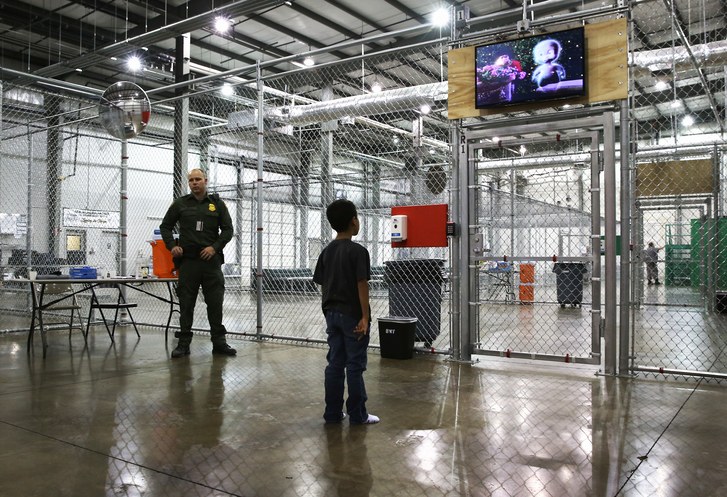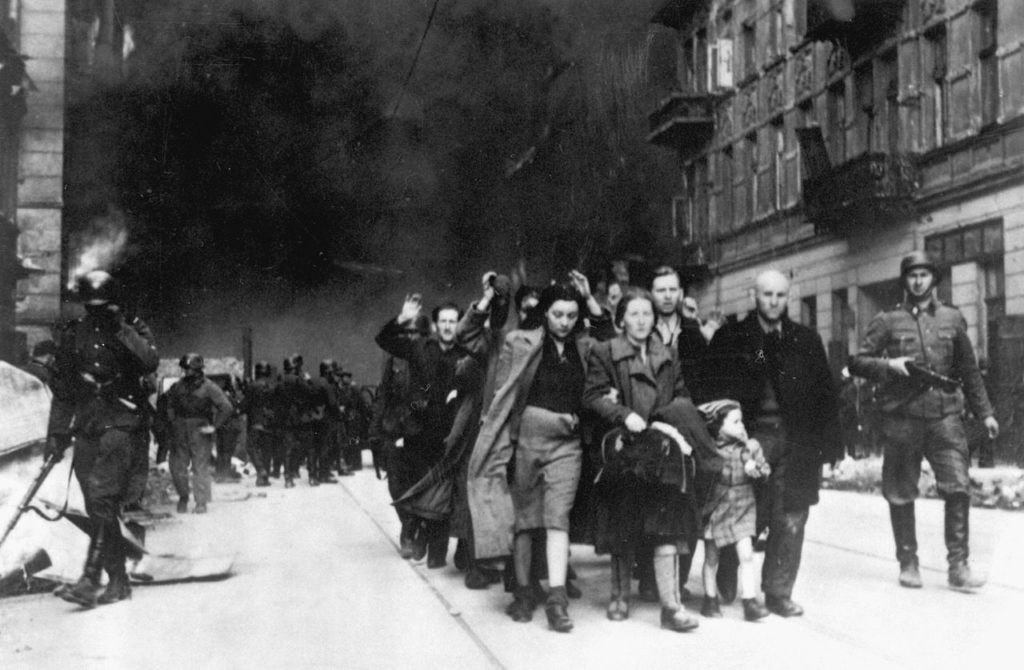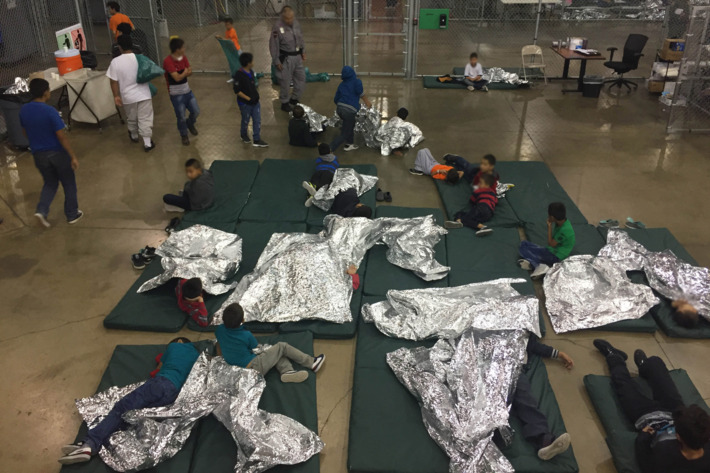Political Feelings
Summer Camp at the Nightmare Factory
“Political Feelings” is a bi-monthly column by Patrick Blanchfield about stories, scenes and studies of religion in American culture.

A boy from Honduras watches a movie at a detention facility run by the U.S. Border Patrol on Sept. 8, 2014 in McAllen, Texas. The Border Patrol opened the holding center to temporarily house the children after tens of thousands of families and unaccompanied minors from Central America crossed the border into the United States during the spring and summer of 2014. (Photo: John Moore—Getty Images)
Writing in 1943, the Polish poet Czesław Miłosz described the light-hearted atmosphere of a peaceful Warsaw plaza while the Jewish Ghetto burned across town. A sky-carousel turned “to the strains of a carnival tune.”
The bright melody drowned
the salvos from the ghetto wall,
and couples were flying
high in the cloudless sky.At times wind from the burning
would drift dark kites along
and riders on the carousel
caught petals in midair.
That same hot wind
blew open the skirts of the girls
and the crowds were laughing
on that beautiful Warsaw Sunday.
The merrymaking of Poles and Germans proceeds apace, even as some 13,000 Jews are murdered and their quarter razed nearby. Their carefree self-indulgence seems – in the most charitable reading – psychotically disconnected from the monstrosity unfolding in front of them. But Miłosz seems to suggest that the proximity in fact charges their fun with a superadded liveliness, even an erotic frisson: a hot wind, fueled by the pyres, that bounces kites and lifts skirts. Visiting the town of Oświęcim (in German, Auschwitz) as a child, I recall being baffled by the existence of discotheque not far from the concentration camp. “How could people still dance there?” I naively wondered. Today, older, I realize how stupid this was. Of course people dance there now; people danced there even then.

A burning street in the Warsaw Ghetto, during the suppression of the Warsaw Ghetto uprising. (Photo: Yad Vashem Archive)
Here is what is happening right now in America. Thousands of immigrant children are being held in mass detention facilities overseen by Federal agencies. The practice of detaining children who arrive at the border unaccompanied is longstanding, and horrifying as is; new to the picture is a “zero tolerance” prosecution initiative, issued by the Trump administration, whereby children who arrive with family members are forcibly separated from them such that they can then, in an evil slight of bureaucratic hand, be declared “unaccompanied.” The adults are sent to trial for illegal border crossing (a misdemeanor), regardless of whether they actually sought to seek asylum (which is entirely legal). Meanwhile, the children are placed in detention facilities – incarcerated – with no clear mechanism for or prospect of reunification with their families; some parents have already been deported, their children left behind. The Secretary of the Department of Homeland Security denies the existence of this policy one day, and then defends it publicly the next. Meanwhile, President Trump blames the Democrats for his own policy – which he could change with the stroke of a pen – and then unsubtly uses the children in question as a bargaining chip in a bid to get Democrats to cosign funding for a Border Wall.
One parent – that we know of – has already committed suicide after being separated from his wife and child. As for the children themselves, some two thousand have already been separated from their families, joining nine thousand other immigrant children already in Federal custody; an official with the Department of Health and Human Services, which manages an array of already overcrowded detention facilities erected on military bases, warehouses, and at least one converted Walmart, estimates that 30,000 could be detained by August. The images and stories that have emerged from such places – that have been glimpsed on carefully managed facility tours or leaked – are horrifying. A 5-year-old from Honduras cries himself to sleep clutching a stick-figure drawing of his family. Children, including a Salvadoran six-year-old, scream for their parents while a Border Patrol Agent mocks their cries. Teens self-harm and threaten suicide while staff are instructed to prevent siblings from hugging.
These scenes, from the present moment, invite justifiable comparison with some of the darkest moments in American history – Japanese internment, the forced removal of Native American children from their parents and communities, the systematic separation of Black slave families. They also cry out for comparison to historic nightmares abroad. They resemble, to be sure, an American version of Romanian strongman Nicolae Ceaușescu’s mass orphanages, the so-called “slaughterhouses of souls” which inflicted trauma on hundreds of thousands of children.
But they are also something else: they are concentration camps. As the historian Andrea Pitzer explains in her authoritative global history of concentration camps, One Long Night, the idea of a concentration camp need not necessarily imply extermination. Pitzer writes,
For more than a century, countries have established refugee camps to coordinate food and shelter during crises. But where the camps exist predominantly to isolate refugees and relegate them to dangerous or inhospitable terrain, serve as de facto detention areas to discourage border crossing, or become permanent purgatory for detainees unable to return home, they begin to take on characteristics of concentration camps. With refugee populations, a clear line does not always mark the peripheries of concentration camp definitions.
This is precisely the territory in which we find ourselves today. As I write, the Trump administration is contemplating erecting mass “tent cities” to house even more child detainees. It is worth recalling that Trump recently pardoned Arizona Sheriff Joe Arpaio, who bragged about building tent cities for immigrant prisoners, which he proudly described as “concentration camps.” Now, it seems, we shall have these for children, and Pitzer herself has called these what they are.
We all know where this goes. Such facilities already are – and only will be more so – incubators for abuse, violence, and health epidemics, mental and physical. We already have an immigration system in which a Texas deputy can cover up “super aggravated sexual assault” of a 4-year-old immigrant child by blackmailing her mother into silence with threats of deportation. America’s prisons and juvenile facilities enshrine violence and sexual abuse as a feature, not a bug – there is no reason not to expect this here. Children will be raped, children will be brutalized, children will die. Meanwhile, the authorities, state media, and regime sycophants will minimize the suffering and dehumanize the victims. Laura Ingraham already tells us these facilities are “basically summer camps,” Ann Coulter says the children are “actors,” and the Secretary of Homeland Security herself warns Americans not to be taken in by the constructed suffering of immigrants “posing as families” to “abuse” our “generosity.” These disavowals, at once breathtakingly divorced from reality but also underwritten by a not-so-subterranean glee in cruelty, will only get more brazen once there are child bodies to count. And even when there are, Tucker Carlson will doubtless remind us that “the American family,” the only family that really matters, faces suffering that is “measurable and real.”
There are not many anti-Nazi jokes that survive from the pre-war era, a fact that testifies, not incidentally, to the thoroughgoing ruthlessness of the German police state. One such rare joke dates from the period when dissenting Germans would still be sent to concentration camps for “rehabilitation” and “reeducation” and then be returned to the general populace. It involves two Germans talking with each other (here adapted from a telling by Vejas Gabriel Liulevicius):
Hans: Georg, you’re back from the KZ, how was it?
Georg: Wonderful! We did calisthenics, took naps, sang songs. There were buffets and lectures in art appreciation. It was a grand time.
Hans: I am surprised – Udo told everyone it was a nightmare of brutality and pain.
Georg: And that’s why he was sent back yesterday!
This joke gets at some key things: that everyday Germans did “know” what was going on; that the pressure to minimize and disavow reality was ubiquitous; and that that pressure came not from fear of security forces foremost – but from fear of one’s own neighbors, who worked as informers. We see very similar mechanisms operative now. The cages are not really cages, DHS says, even if yes, technically speaking, it admits that the phrase is “not inaccurate”; the appropriate phrase, per Fox’s Steve Doocy, is “walls [built] out of chain link fences.” Their staff are not camp guards, they are “Consequence Delivery Agents.”
In this nightmare factory we call America, where people sic armed, trigger-happy police on one another out of sheer racism, and where people routinely threaten deportation against neighbors whom they wish to tormentor exploit, the sense of mounting fear, and of joy in cruelty, lurking behind the jokes and circumlocution is palpable. But our pretenses of not-knowing are even flimsier than those of Germans living under Nazism. The photos of immigrants’ confiscated rosaries and clothes come in real time, our moment’s analogues to the piles of shoes and tallitot at Auschwitz. They are glimpses of a present incubating a future that only promises worse. Action is necessary – from acts of civil disobedience to support for activist groups to demands for the abolition of ICE, CBP, and DHS and more. And so too is an honest confrontation with the uncomfortable truth that these new horrors also represent a clear continuity with our all-too-recent past.
We have no excuses. All that is unfolding now is happening against the backdrop of a period of record stock market gains and unprecedented wealth. If we permit such things now, what do we license when – not if – things get worse? The hot winds are already blowing.
***
Patrick Blanchfield was the 2016-2017 Henry R. Luce Initiative in Religion in International Affairs Post-Doctoral Fellow at the Center for Religion and Media at NYU. He holds a PhD in Comparative Literature from Emory University and is a graduate of the Emory University Psychoanalytic Institute. He writes about US culture, guns, and politics at carteblanchfield.com and is on Twitter as @patblanchfield.
***
Published with support from the Henry R. Luce Initiative on Religion in International Affairs.
